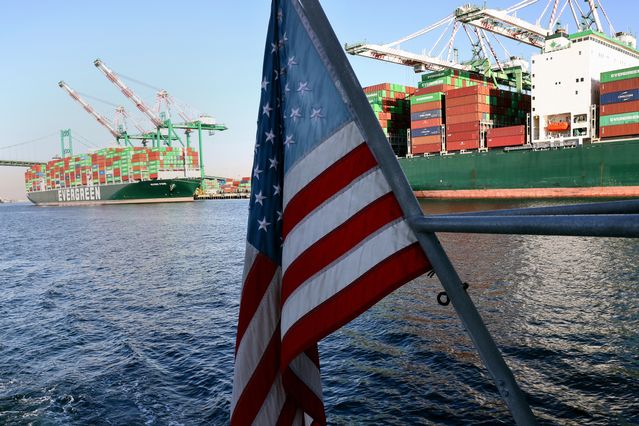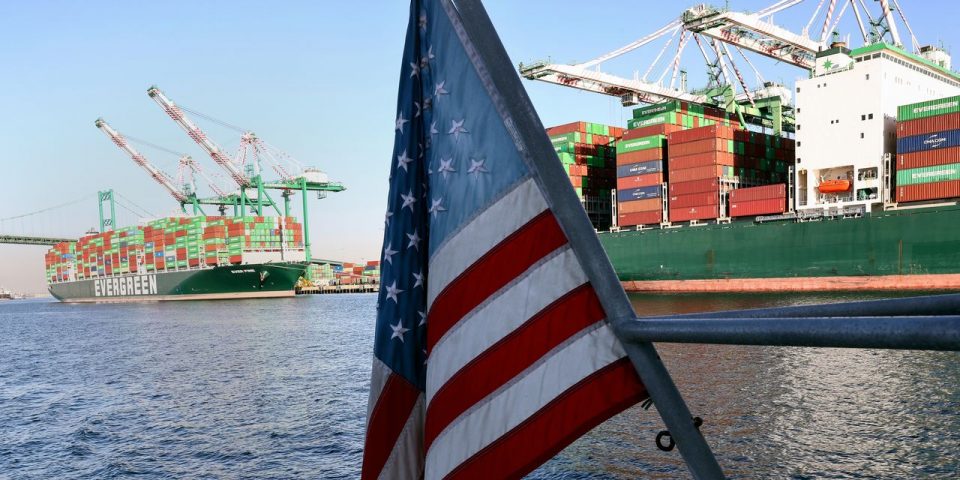Text size

An American flag flies from a ferry passing container ships at the Port of Los Angeles on Nov. 24, 2021 in San Pedro, Calif.
Mario Tama/Getty Images
About the author: Christopher S. Tang is a university distinguished professor and Edward W. Carter chair in business administration at the UCLA Anderson School of Management.
President Biden’s Nov. 18 summit with Canadian Prime Minister Justin Trudeau and Mexican President Andrés Manuel López Obrador was cordial. But then the discussion went cold.
It is worrisome that the protectionist policies all three countries have now signed onto could hinder economic development and supply-chain resiliency in North America.
Instead of focusing on the slice of the pie that each country can get from the U.S.-Mexico-Canada trade deal known as the USMCA, all three leaders would be better off developing grand visions that can create a much bigger pie. The value for North America would be transformative, going beyond trade.
To recap, the USMCA signed by President Donald Trump is different from its predecessor NAFTA, signed by President Bill Clinton in 1993. Here’s how.
Relative to NAFTA, the USMCA seeks to raise standards for workers in North America, including those related to freedom of union formation and the right to collective bargaining. The new deal allows U.S. farmers to gain access to the Canadian dairy market. It also adds digital trade provisions to reflect big economic changes since the 1990s.
The thorny part of the USMCA involves car and truck manufacturing. To quality for zero tariffs, imported vehicles must have 75% of their components manufactured in the U.S., Mexico, or Canada. Also, 40-45% of automotive contents must be made by workers making at least $16 per hour. Because autoworkers in Mexico earn much less than their American and Canadian counterparts, this new deal exerts pressure to wage hikes in Mexico, which negate Mexico’s low-cost advantage.
Making matters more complicated, Trudeau and López Obrador have expressed concerns over a protectionist-motivated proposal in Biden’s big social-spending bill. This provision gives consumers a tax write-off of $12,500 when they buy an electric vehicle, but only if they were assembled by union workers using American-built batteries.
On Friday, Canadian officials threatened to impose tariffs if the U.S. moves forward with the tax credit.
Instead of focusing narrowly on protecting union workers in the automotive sector, the Biden administration should be working to unleash the hidden potential of the USMCA by increasing trade flows among the U.S., Mexico, and Canada.
How can one increase trade flows when the U.S. is facing a supply-chain crisis that ranges from congested ports to shortages of workers and warehouse spaces?
Despite the all-out efforts exerted by the Biden administration, Transportation Secretary Pete Buttigieg has acknowledged that supply-chain issues could take months to address. As short-term fixes, major retailers
Walmart
and Target chartered their own cargo ships to unload their containers in less congested ports, while
Levi Strauss
and Lands’ End relied more on air freight to receive their shipments of goods from Asia.
In the long-term, the partnership in the spirit of USMCA can create unprecedented opportunities that all three leaders must seize.
First, the proposed tax write-off for buying electric vehicles is meaningless to low-income consumers who are struggling with price inflation. Instead, we should support the auto factories in Mexico and Canada to produce affordable cars for American consumers.
We should also support toy and PPE manufacturing in Mexico. Not only are the manufacturing wages in Mexico lower than in China, the proximity can also ensure supply-chain responsiveness and resiliency in the long-term.
Second, in Mexico, the economy is growing rapidly in the northern part of the country, in states such as Baja California and Coahuila. But poor infrastructure has limited growth in Chiapas, Oaxaca, and other parts of southern Mexico. President Lopez Obrador should improve the requisite infrastructure in Mexico to entice more foreign direct investment to strengthen its economy.
Economic growth in the south may open opportunities for migrants from Central or South America to find jobs in Mexico, which would help address the border issue for the United States.
Third, increased use of rail freight within North America could help to reduce greenhouse gas emissions created by jumbo container ships. Consider the merger between
Canadian Pacific
and
Kansas City Southern in late October, which will create the first single-line rail network that connects the U.S., Mexico, and Canada. Instead of shipping one container on each truck, a freight train can carry many. The reduction in greenhouse gas emission significantly.
Besides rail freight, Mexico can develop its ports in Ensenada and Larzaro Cárdenas further. These ports can serve as alternatives on the west coast where customs can be cleared under the USMCA. Also, Mexico’s Gulf ports, such as Veracruz, can transport products to U.S. ports in Louisiana and Alabama, creating additional job opportunities in these historically poorer states.
The USMCA can be a catalyst for three leaders to build a much stronger North America that can create transformative value for all three countries. After all, good neighbors are priceless.
Guest commentaries like this one are written by authors outside the Barron’s and MarketWatch newsroom. They reflect the perspective and opinions of the authors. Submit commentary proposals and other feedback to [email protected].


